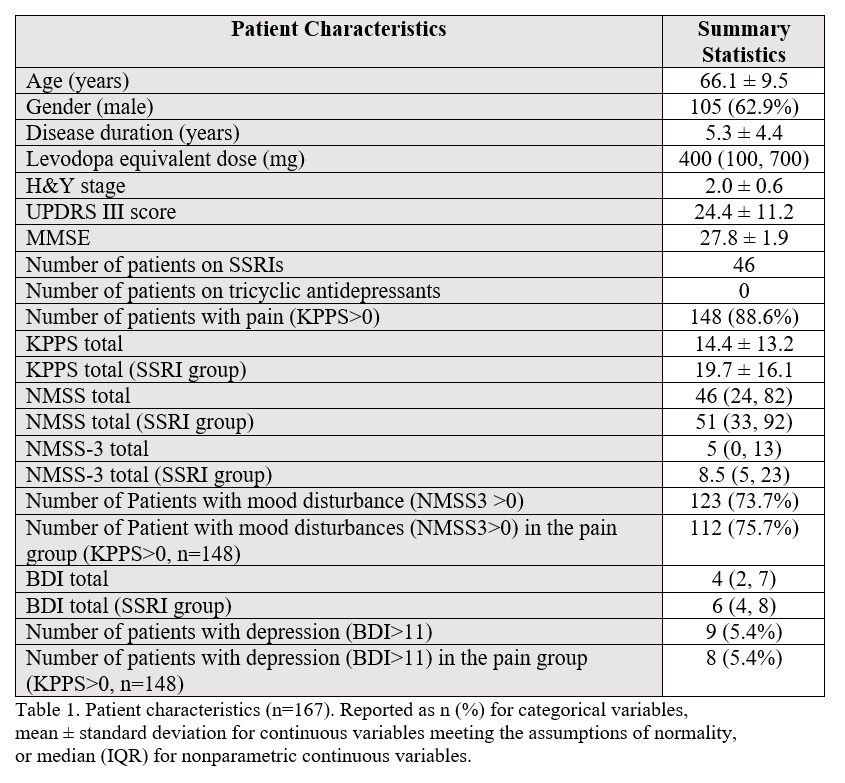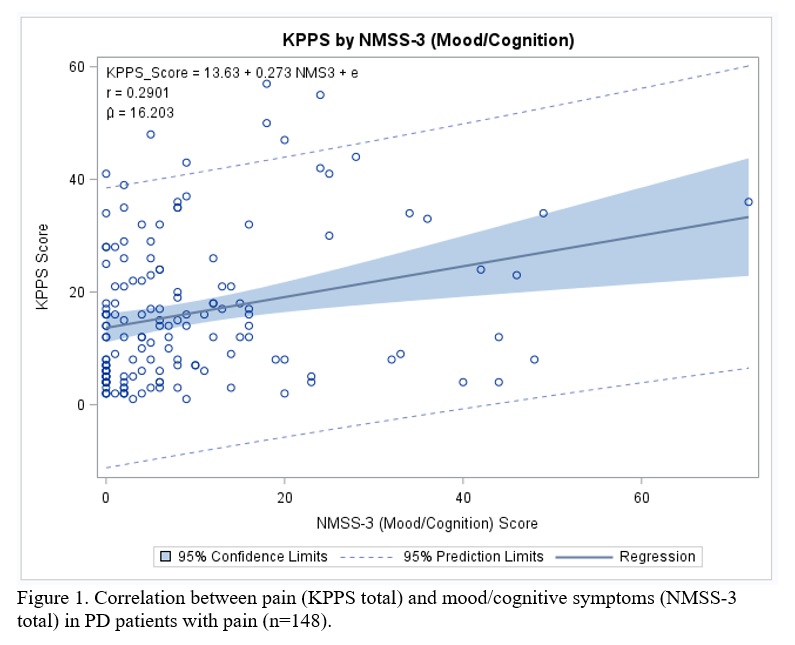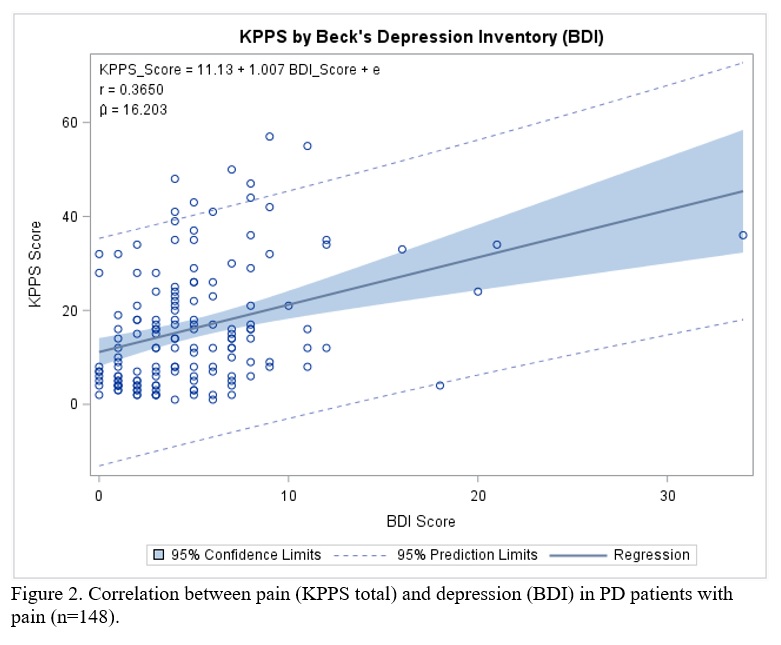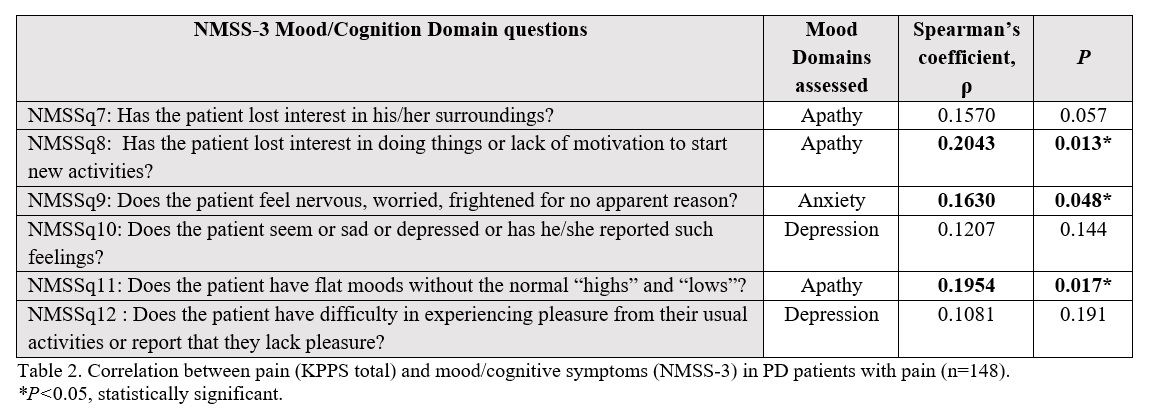Session Information
Date: Wednesday, September 25, 2019
Session Title: Non-Motor Symptoms
Session Time: 1:15pm-2:45pm
Location: Agora 3 West, Level 3
Objective: This study aims to investigate the relationship between pain and mood disturbances in patients with Parkinson disease (PD).
Background: Pain and mood disturbances are distressing non-motor symptoms (NMS) in PD.[1][2] There is inconsistent data about the correlation between pain, depression, and anxiety in PD,[3][4][5] and little information about the relationship between apathy and pain in PD. Characterizing these relationships may be helpful to provide holistic treatment for PD patients.
Method: This is a cross-sectional, observational study of consecutive patients with idiopathic PD, ages 18-85, evaluated at two academic centers. Subjects were assessed with the UPDRS III, King’s PD Pain Scale (KPPS), Non-Motor Symptoms Scale (NMSS) and Beck Depression Inventory (BDI). Exclusion criteria included atypical Parkinsonism, cognitive impairment (MMSE < 24/30), severe disability (H&Y stage >4), or other diseases causing acute or chronic pain. Spearman’s rank correlation coefficient, ρ, was used for data analysis.
Results: 167 patients were enrolled and 88% (n=148) experienced pain (defined as KPPS total > 0) [table1]. Pain correlated significantly with mood/cognition disturbances on NMSS-3 (ρ=0.29, P<0.001, [figure1]) and depression on BDI (ρ=0.37, P<0.001, [figure2]). Pain subtypes of musculoskeletal (ρ=0.21, P=0.009) and chronic pain (ρ=0.18, P=0.032) had a significant correlation with mood disturbances (NMSS-3). Selective serotonin reuptake inhibitor (SSRI) use by 46 patients did not lower KPPS, BDI, or NMSS-3 scores [table1]. NMSS-3 questions were classified as representing depression, apathy, or anxiety based on DSM V criteria and peer-reviewed definitions [table2].[6][7] Of the mood disturbances, apathy had the strongest correlation with pain [table2].
Conclusion: The presence of pain in PD is associated with various mood disturbances, including depression, anxiety and apathy. Our data shows that apathy may contribute significantly to this relationship, which was not previously recognized. Future studies using tools specifically assessing apathy might further elucidate this relationship between apathy and pain in PD.
References: [1] Pfeiffer, R. (2016). Parkinsonism Relat Disord. 22: S119-22. [2] Schapira, AH., et al. (2017). Nat Rev Neurosci. 18(7): 435-450. [3] Ehrt, U., et al. (2009). Am J Geriatr Psychiatry. 17: 269-75. [4] Rana, AQ., et al. (2017). Clin Neurol Neurosurg. 160:1-4. [5] Rana, AQ., et al. (2016). Int J Neurosci. 126(2): 116-20. [6] American Psychiatric Association. (2013). DSM V. [7] den Brok, MGHE., et al. (2015). Mov Disord. 30(6): 759-69.
To cite this abstract in AMA style:
C. Vila, A. Sparks, P. Imbriani, N. Caputi, L. Covington, T. Schirinzi, S. Natoli, A. Pisani, P. Ghosh. Exploratory analysis of the relationship between pain and mood disturbances in Parkinson’s disease [abstract]. Mov Disord. 2019; 34 (suppl 2). https://www.mdsabstracts.org/abstract/exploratory-analysis-of-the-relationship-between-pain-and-mood-disturbances-in-parkinsons-disease/. Accessed April 4, 2025.« Back to 2019 International Congress
MDS Abstracts - https://www.mdsabstracts.org/abstract/exploratory-analysis-of-the-relationship-between-pain-and-mood-disturbances-in-parkinsons-disease/




